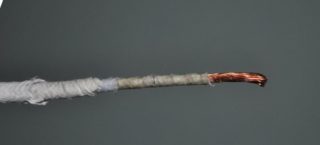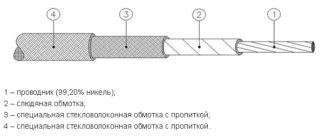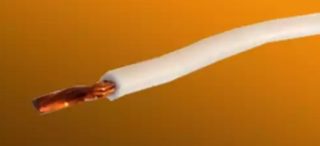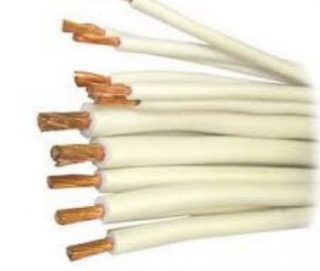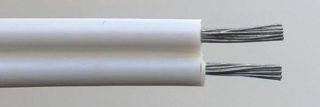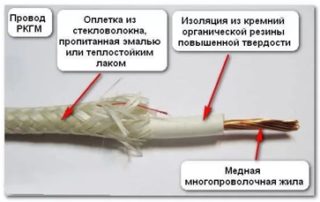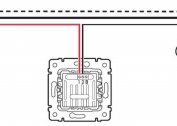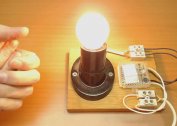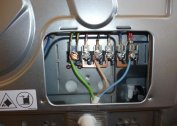The influence of various negative factors can threaten the integrity and performance of electrical equipment. For this reason, special heat-resistant wires are installed. They have an additional insulating layer made of non-flammable material. Depending on the model, the wire will have different parameters. The choice of the best option depends on where it will be laid.
Varieties of heat-resistant wires
Since the wires can be used in different conditions, the requirements for them will also differ. Each model will have its own resistance to adverse factors and operating conditions. These features must be considered when choosing the optimal conductor. Popular types of conductors for connection are RKGM, PRK, PRKS, PAL and others.
The listed models tolerate high temperature well. At zero and negative temperatures, other conductors are used.
RKGM
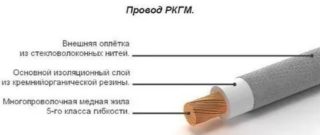 The most used heat-resistant wire is RKGM. It has the following characteristics:
The most used heat-resistant wire is RKGM. It has the following characteristics:
- voltage up to 660 V;
- cut area from 0.75 sq. mm. up to 120 sq. mm;
- temperature range from -60 ° to + 180 ° C;
- 1 core;
- minimum operating time, subject to requirements, is 8 years;
- inert to atmospheric pressure drops;
- resistance to mold;
- withstands vibration, mechanical stress, solar radiation, radiation.
The main working element of the design is a copper multi-wire core. It has a fifth class of flexibility. The cores are coated with silicone insulation. The outer layer is fiberglass yarn.
Silicone and fiberglass are resistant to temperature and moisture, are non-combustible and non-melting. Having multiple protective layers provides the best security and protection. It is actively used in saunas, bathrooms, basements.
MVV
Heat-resistant MVV wire can withstand temperatures up to + 500 ° C for a long time. It is resistant to ignition, but works worse at low temperatures.
Characteristics:
- works in electric networks up to 500 W;
- section from 1 sq. mm. up to 25 sq. mm;
- single core;
- working temperatures from -60 ° to + 500 ° C.
Application - electrical appliances and powerful equipment, hot shop, baths, industrial premises with the presence of chemical elements. Also used in heating components.
PRKA
Heat-resistant wire with a copper core at the base and silicone rubber sheath is used in rooms with high humidity. These include bathrooms, baths, steam rooms, pools, production halls and other types of facilities with unstable microclimate.
Main parameters:
- rated voltage up to 660 V;
- section from 0.5 sq. mm. up to 2.5 sq. mm;
- temperature conditions from -60 ° to + 180 ° C;
- single core.
Does not support combustion. No halogen braided.
PRKS
Stranded wire high-temperature PRKS stands for copper connecting conductor with silicone insulation.
Parameters:
- works up to 380 V;
- cross section from 0.75 sq. mm. up to 10 sq. mm;
- temperatures from -60 ° to + 180 ° C. Short-term use up to 250 ° C is possible;
- number of cores from 2 to 5;
- used in cooking shops, saunas and other facilities with extreme conditions.
This model is used at high temperatures with jumps up to + 250 ° C. It does not emit toxic substances. Stranded wire can be used to transfer electricity up to 30 kW.
PVCW
Heat Resistant Wire Marking:
- P - wire;
- In - application for the output ends of electric machines;
- KV - two-layer isolation from silicone rubber.
Parameters:
- voltage up to 400 V;
- sectional area from 0.5 sq. mm. up to 95 sq. mm;
- operating temperature up to 200 ° C;
- number of cores - one or more;
- it is applied in single laying in rooms, mines, tunnels;
- does not melt, does not burn;
- resistant to atmospheric pressure surges.
The most common scope of PVCH is the connection of the output ends of electrical installations to an alternating voltage of 660 V or 1140 V, as well as the winding conclusions of class N. It can be operated in high humidity and fire hazard.
PMTK
The interpretation of the wire shows that it is heat-resistant and has a protection made of organosilicon material. It works in electric networks up to 660 V and temperatures up to +200 degrees Celsius. On sale you can find single-core and multi-core conductors with a cross section of up to 4 sq. Mm.
It is actively used in places with increased risk of fire. It can be put in baths, saunas, hot shops, in production. Withstands temperatures up to 180 ° C.
Properties of heat-resistant cables
Heat-resistant products have improved protection compared to classic conductors. This has led to the fact that the service life of such electrical installation devices is significantly increased. The cable can be covered with such types of protection that will allow it to be installed even in places with a high risk of bacterial or chemical damage. The protective layer is resistant to the formation of fungus, mold and other crops on the surface of the cable.
The cable tolerates high temperatures better. In cold weather, the protective coating may crack, causing the conductor to become unsuitable for further use.
When buying a device, you need to familiarize yourself with its characteristics in advance so as not to make a mistake in the operating conditions of a particular model.
Area of use
Heat-resistant stranded wire is intended for use in such operating conditions when a conventional conductor cannot be mounted. A heat-resistant wire is selected depending on the intensity of external factors.
The main areas of application for heat-resistant wires are:
- Wiring indoors, especially in buildings with a high risk of fire hazard.
- Laying cables on the street. Here, environmental factors will act on the conductor - weather conditions, precipitation, direct sunlight.
- Winding electrical installations and AC machines.
- Installing wires for high temperatures in an environment with chemicals or a bactericidal threat, as well as the risk of mold fungi.
- Installation in objects in which sharp temperature jumps are observed.
A heat pipe with a braid or seal can be used to connect components of electric stoves, electric furnaces. You can also install an additional tube for the wire to protect it from damage or contamination.
Popular mistakes in choosing a cable are incorrect determination of the cross section and the purchase of products of the wrong temperature range. For this reason, it is important to think in advance where the cable will be laid, and measure the necessary values.
